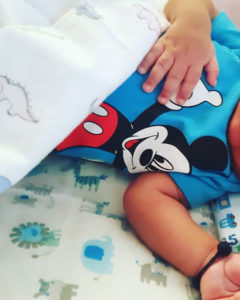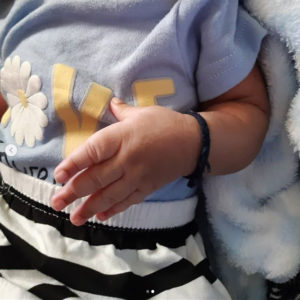Diamond and Tanasha´s son ´black charm´ stirs controversy online
Mama Dangote has been forced to respond to online fans regarding her grandson´s wrist charm that many believe is a sign of witchcraft.
The aging granny who has been spoiling fans with photos of her new bundle of joy through online posts, has put herself at a tight spot.
This is after recent photos showing a black band tied to the baby boy´s left arm wrist and that has sent signals of being a ¨black charm¨.
 Baby Simba with a black band around his left arm´s wrist
Baby Simba with a black band around his left arm´s wrist
A fan identified as Ancilaassenga posed:
Mshafunga dawa Mungu mbona ndo kila kitu, calendar imewaacha nyuma sana bado mpo hukoo. (You have already introduced this young one to such beliefs yet God is the only answer, you are still living in the old days)
Before Sanura savagely responded:
Ndio zetu watandale (That is our culture)
According to many beliefs, such charms are intended to protect kids from evil eyes and prevent any form of sickness.
 Mama Dangote´s grand son, Baby Simba
Mama Dangote´s grand son, Baby Simba
Comment section
Fans are yet to get satisfied with her kind of response and flooding the comment section hit back:
Vipi kuhusu icho kifundo cheusi cha kazi gani mkononi
@ushindimaarifa Huo ni mvuje kwa ajili ya mapepo au ilibilisi
@ushindimaarifa hehehehe hirizi….uuuuiii kwani huamaanisha Nini jamani?? Ama ndo bangle ya maridadi
@krasheedy kuzuia nn ukihitajika unafatwa vizuri sema tu watu hawana iman na muumba wao wanamsema kwa midom yao ila roho zao ziko kwa waganga
@liliansaharan umeona mi wanangu hawaji kufungwa ushenzi Kama huo. Mtoto analindwa na Mungu unatamiwa kila kitu kumkabizi Mungu yaani na Tanasha kakubali upuuzi huo khaaa. Mtoto anafungwa ushetani akiwa mdogo mpaka anakua anamizigo kibao,Mungu ndio kila kitu
@ushindimaarifa mimi mwenyewe nashangaa mtoto mzuri kifundo tena
@ancilaassenga Even in Mombasa they do that alot when babies are born..waislam wengi hufanya hivyo ni utamaduni….hata wewe kunakitu unakiamini… ..stop being judgemental over other people’s beliefs , practices and culture.









